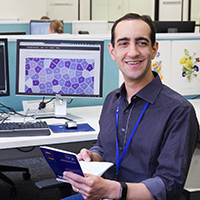Keeping a watch on how people react to medicines.
 As is evident by our unique fingerprints, every human being is built differently. So everybody (and every body) reacts to medicines differently. And that can create trouble when a doctor inevitably writes a prescription based on the ‘average person’. Especially when that person is aged.
As is evident by our unique fingerprints, every human being is built differently. So everybody (and every body) reacts to medicines differently. And that can create trouble when a doctor inevitably writes a prescription based on the ‘average person’. Especially when that person is aged.
For some, it means their health may simply not improve, while others can suffer side effects, like drowsiness. Even worse, those using multiple medicines (known as polypharmacy) could face significant risk of impairment, either cognitive (dementia) or physical (frailty).
It’s one of the defining problems being tackled by the University of South Australia’s Quality Use of Medicines & Pharmacy Research Centre. Led by Professor Libby Roughead and championed by senior researchers Doctor Andre Andrade and Doctor Renly Lim, the aim is to reduce medicine-induced deterioration and adverse reactions in older people living in residential aged care.
The number of people affected is staggering. In Australia, around 250,000 hospital visits every year are related simply to issues created by medicines. Not only is this reducing the potential health benefits for a lot of people, it’s also adding $1.4 billion a year to government – and taxpayer – expenses.
Now, the tantalising truth is that half these problems are known to be preventable. The question is how. After all, doctors aren’t with their patients 24/7 and thus, during an examination, rely on what is subjectively reported. The problem is none of us are particularly sensitive to small progressive changes in our own constitution and it’s hard to keep track of everything that happens to us, whilst some tend to concentrate more on what’s happened most recently to them.
So, Doctor Andrade and Doctor Lim are testing wearable devices on 200 aged-care residents. Excitingly, these ‘wearables’ can take many forms, depending on the need. But far from exotic or expensive, the ones they’ve been using are the electronic wristbands commonly used for exercise tracking or as watches. Impressively, these devices come packed with sensors – including an accelerometer – that allow them to measure two major biosignals: movement and temperature. With this data uploaded to a web-based system developed by UniSA, the residents’ activity and sleep patterns can be interpreted.
And it’s these so-called digital biomarkers that Andre and Renly hope will help them find an objective measure for frailty that could be used to detect and prevent medicine-induced problems. From that small user-friendly device, doctors could detect early adverse reactions, predict the patient’s response to therapy and decide when and how to start, modify or cease medication.
But that’s just the start. A wearable that measures a patient’s tremors could provide the digital biomarkers for Parkinson’s disease; a tablet computer monitoring handwriting or recording voice alterations could pick up cognitive impairment and dementia; humidity sensors could help patients with incontinence; portable electroencephalograms could predict seizures; and the sensors in a smartphone could even provide the data to detect some mental conditions such as depression.
It may not be long before the watch on your wrist really will allow doctors to keep a digital watch on your health.



